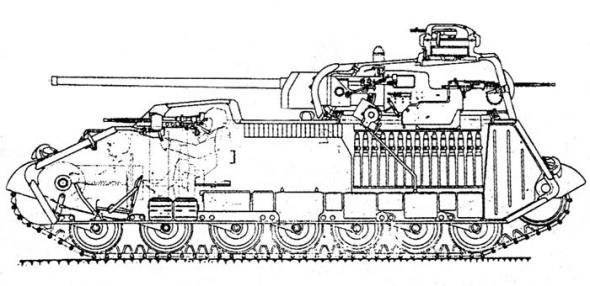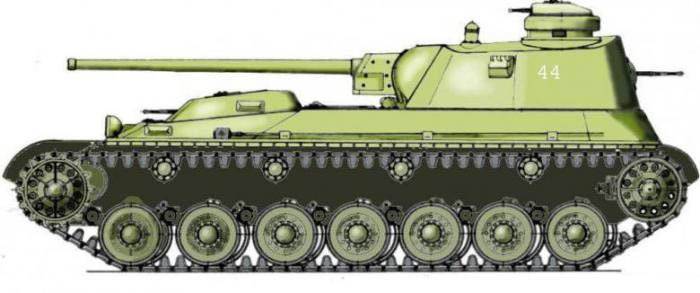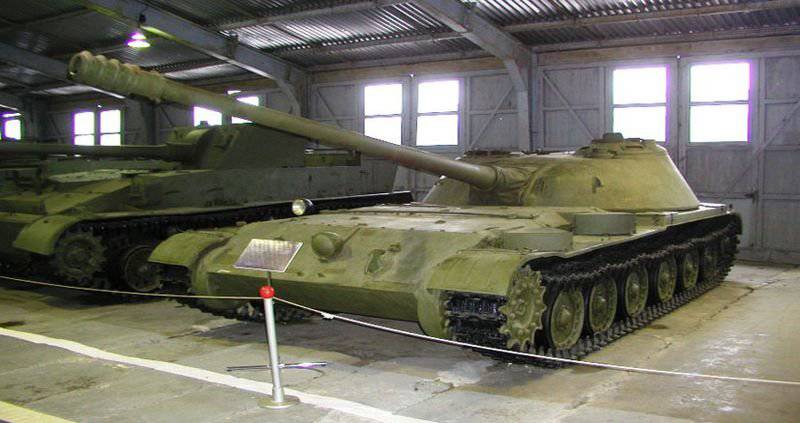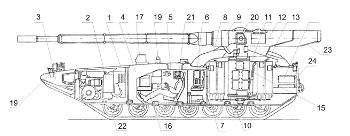Long before "Almaty". Domestic tanks with front engine
A-44
At the very beginning of 1941, the designers of Kharkov Machine-Building Plant №183, under the leadership of A.A. Morozov, on his own initiative, began the development of a project that received the designation A-44. At this time, Kharkov engineers worked on the development of the T-34 tank, which was proposed to be equipped with an updated hull and a new undercarriage. In the course of scientific and tactical research, the design team came to the conclusion that the current trends in the development of tank building do not leave much choice. New medium tanks had the same weapons as the last heavy ones. The average armored vehicles were faster and more maneuverable. The result of the collision of medium and heavy tanks was no longer clear in advance. Based on this, Morozov and his staff suggested strengthening the armament of the medium T-34 and adjusting its design accordingly.

However, a simple rework design did not work. Preliminary calculations of the centering of the A-44 tank showed that the most sensible solution would be to place the fighting compartment in the stern of the tank, and the transmission and engine should be moved to the front and middle parts of the hull, respectively. With this arrangement, it was possible to simultaneously provide adequate levels of protection and firepower, as well as leave sufficient internal volumes to accommodate the crew and solid ammunition. By the end of April, an outline design was prepared for 41, which meant the creation of three tanks with different weapons and armor on one base. Thus, the thickness of the frontal armor of the three options A-44 was equal to 75, 90 and 120 millimeters, and the airborne - 60, 70 and 100 mm. For that time it was more than good. Most anti-tank guns, created in the late thirties, could only leave dents on rolled sheets of such thickness. However, at the cost of good protection, first of all, a large mass has become. The lightest and weakly protected version of A-44, according to calculations, weighed 36 tons, the heaviest — all fifty.
Of particular interest is the layout of the internal volumes of the armored hull. In front of it, behind thick armor, it was proposed to place the transmission. These were the multi-plate main friction clutch for dry friction, a manual gearbox, two side clutches and one-stage side gearboxes. Immediately behind the transmission units was the workplace of the driver and only after him, in the middle part of the car, was the engine compartment located. The engine compartment volumes allowed the installation of a B-5 diesel (600 hp) or B-6 (850 hp) diesel, depending on the specific type of tank. The 36-ton version of А-44 was supposed to be equipped with a less powerful engine, and the medium and heavy versions - with a 850-strong B-6. All powerplant options provided specific power at the 15-18 HP level. per ton of weight. For tanks of the early forties, this was considered sufficient. The chassis of all three A-44 was almost the same, all differences related to depreciation. On each side of the tank had seven road wheels and four supporting. The road wheels had a torsion bar suspension. The drive wheel sprocket hitch, as is clear from the layout of the transmission, located in front of the machine. The guide wheel, in turn, was located in the stern of the hull.
Estimated running characteristics of the prospective A-44 family of tanks were quite large. The lightest of them could accelerate on the highway to 65 km / h, the heaviest - to 53 km / h. Cruising, depending on the specific type, ranged from 250 to 300 kilometers.
The range of weapons A-44 tanks was quite wide. As the main weapons 57-mm gun ZIS-4, 76-mm ZIS-5 or even ZIS-6 caliber 105 mm were proposed. In all three cases, it was planned to install one or two twin DT machine guns. Ammunition 57- and 76-millimeter guns were 160 shots, as for the shells for 105-mm guns, only 60 units were placed in the fighting compartment. The A-44 auxiliary armament consisted of one or two DT machine guns paired with machine guns, machine guns in the wheelhouse behind the driver’s workplace and in the rear of the tower. In addition, an installation for a PPSh submachine gun or anti-aircraft machine gun could be installed in the commander's turret. The total ammunition of all machine guns was 2600 cartridges.

The crew of tanks A-44 of all versions consisted of five people. The driver was located in front of the car, to the left of the longitudinal axis. Immediately behind him, in a special wheelhouse with a machine gun, was the workplace of the gunner-radio operator. The commander, gunner and loader, in turn, were placed in the tower. The commander had at his disposal a small turret on the roof of the main tower, which was equipped with observation devices and an embrasure. It was proposed to land and leave the tank through three hatches: one on the cockpit of the radio operator, the other two - on the roof of the tower. Since the crew of the tank was divided and worked in two separate volumes, the installation of an A-44 tank intercom and light alarm for the interaction of the commander and the driver was assumed.
In May 1941 of the year, all three versions of the A-44 tank, along with the mock-up, were presented to the commission of the Main Armored Directorate. The project was recognized successful and the designers recommended to continue development. According to the decision of the commission, the main work on the A-44 topic should have started by the end of the summer of the same year and by January 42 should be built a prototype of one of the structures. Most likely, the light version of the tank could become a prototype: the GABTU commission recommended reducing the combat weight of the new tank to 28-30 tons. However, the German attack canceled out plans to create a promising family of armored vehicles on a single base. The need to evacuate the Kharkov Machine-Building Plant, as well as the new requirements of the time, did not allow to build at least one prototype А-44. Moreover, it was not possible to even complete the preparation of documentation for the assembly of a prototype.
"416 Object"
The return to the alternative layouts of the tank took place only ten years after the project A-44 was closed. It is worth noting, by the time the location of the engine is not in the stern de facto became the standard for self-propelled artillery installations. Therefore, a number of problems of this layout has already been solved and it was possible to quietly introduce it into other classes of armored vehicles. At the very beginning of the fifties, the design team of A.A. Morozova worked on the issue of reducing the frontal projection of a promising tank. The second question confronting the engineers concerned the initial velocity of the projectile. A promising tank should have been able to destroy not only the enemy’s medium armored vehicles, but also heavy ones. This required a long-barreled weapon, which was, at least, very difficult, if not impossible, to fit into the dimensions of a classic-style tank.

In 1950, the first iteration of the 416 Object project appeared. This promising tank combined all the desired characteristics at the same time. Thanks to a number of original solutions, the 416 Object had a maximum height of no more than 180-185 centimeters and carried an 100-mm gun with a barrel length of 55 calibers. According to calculations, such a weapon could send to the target caliber projectile with an initial speed of a little more than a kilometer per second. Sub-caliber ammunition, respectively, had even greater speed. A characteristic feature of the "Object 416" was a relatively small mass with solid armament: the maximum combat weight of the tank did not exceed thirty tons. However, for the fire and weight qualities had to pay, above all, the level of protection. The maximum thickness of the hull armor plates was 75 millimeters, and the cast turret was 110 mm. Even the older T-44 had thicker armor.
The layout of the “416 Object” was somewhat similar to A-44, but had some significant differences. So, in front of the armored hull was installed not only the transmission, but also a diesel engine with a power of about 400 horsepower. Through a five-speed gearbox and planetary rotation mechanisms, the engine torque was transmitted to the drive wheels in front of the car. The undercarriage of the “416 Object” was equipped with six support rollers with a torsion bar on each side. According to the “fashion” of that time, the track rollers were large and simultaneously served as supporting rollers.
At the rear of the vehicle was a fighting compartment with a rotating turret. It is noteworthy that the relatively large horizontal dimensions of the latter allowed to place the jobs of all four crew members in the same volume. True, the need to turn the tower required to develop a system to stabilize the driver's seat. As a result, we managed to make a thing unique for tank building: despite the angle of turn of the tower, the driver inside was always looking ahead in the direction of travel. A special platform inside the habitable volume compensated for the turn of the tower. The only inconvenience for the driver was the movement of his workplace from side to side. Nevertheless, the training was supposed to help get used to this tank feature. The jobs of the commander of the vehicle and the gunner were much more familiar and did not require much habituation, which is not the case for the loader. Since the tank "Object 416" had a uniquely low height, all internal volumes were appropriate. Because of this, the loader was no longer able to kneel on the floor of the fighting compartment; he had to either sit on a small landing place or kneel. Under such conditions, carrying the 100-mm unitary shots was far from simple.

Probably, working with less heavy and large projectiles would be simpler, but the Perm gun M-416, made on the basis of the D-63 tank gun, was chosen as the main weapon for the “10 Object”. It differed from the M-63 prototype with a long barrel in 55 calibers, as well as a new multi-chamber muzzle brake of the original design. In addition to the new cannon on the promising tank, it was proposed to install original suspension devices. Thanks to them, the crew had the opportunity to direct the gun horizontally, not only by turning the turret. Fine targeting was carried out within the sector width 20 °. Vertically, the gun swung from -6 ° to + 35 °. 35 shells were housed in the fighting compartments. The additional armament of the “416 Object” initially consisted of one SGMT machine gun coupled with a gun.
Initially, the 416 Object project was proposed as a new medium tank with increased firepower. However, restrictions on the mass and, as a result, weak booking forced the engineers to reconsider the class of the armored vehicle. Frontal armor in 75 millimeters did not provide the required level of protection. Therefore, the tank "416" soon after the completion of the preparation of the draft design turned into a self-propelled artillery installation. In this connection, several structural changes were carried out, but the majority of technical solutions remained the same. Already in the status of ACS "Object 416" was built in a single copy. In 1952, the prototype, sometimes referred to as SU-100М, passed state tests, the results of which it was decided not to accept the installation on weapons. The fact is that the new self-propelled gun had almost no advantages over the existing types. In addition, a number of units, such as the system of rotation of the workplace of the driver or suspension devices of the gun, greatly complicated the design, complicated maintenance and led to an increase in the cost of the entire combat vehicle. As a result, the only assembled "Object 416" was transferred to the tank museum of the city of Kubinka, where it is still kept.
"The leader of 2000-2005"
At the very end of the eighties, at the Leningrad Kirov Plant, they began developing a project with the cipher "Leader 2000-2005." As the name implies, this tank was to become the basis of domestic armored forces at the beginning of the 21st century. Developing the current trends in the evolution of main tanks, LKZ engineers decided to abandon a number of customary solutions, including the classic layout. As a result, another tank project emerged, whose engine and transmission are located in the front. In addition, the project "Leader 2000-2005" was one of the first domestic developments, where special attention was paid to an increased level of crew protection.
 It should be noted, the first step to increase the level of protection was precisely the engine compartment in front of the case. Thus, the projectile, which penetrated the frontal armor of the tank, was stopped by the engine, even at the cost of the latter’s efficiency. However, frontal protection still had to be pierced. The Leader's composite frontal pack was equivalent to a homogeneous 800-900 slab of millimeters thick enough to protect against most of the anti-tank weapons that were then available. In the middle part of the armored hull of a prospective tank, there was a control compartment, which was a sealed volume with thick walls. Thanks to this solution, the probability of hitting the crew was reduced several times. It is noteworthy that special attention with regard to protection did not negatively affect the driving characteristics of the project tank. With a gas turbine engine with a power of about 1700 hp "The leader of 2000-2005", according to calculations, accelerated along the highway to 90-95 km / h.
It should be noted, the first step to increase the level of protection was precisely the engine compartment in front of the case. Thus, the projectile, which penetrated the frontal armor of the tank, was stopped by the engine, even at the cost of the latter’s efficiency. However, frontal protection still had to be pierced. The Leader's composite frontal pack was equivalent to a homogeneous 800-900 slab of millimeters thick enough to protect against most of the anti-tank weapons that were then available. In the middle part of the armored hull of a prospective tank, there was a control compartment, which was a sealed volume with thick walls. Thanks to this solution, the probability of hitting the crew was reduced several times. It is noteworthy that special attention with regard to protection did not negatively affect the driving characteristics of the project tank. With a gas turbine engine with a power of about 1700 hp "The leader of 2000-2005", according to calculations, accelerated along the highway to 90-95 km / h.Since the crew of a two-person tank had to work in a separate volume from the reserved volume, LKZ engineers had to develop an uninhabited fighting compartment. In it, inside the armored hull, was placed a double-ring automatic loader with ammunition and a system of supplying shots upward to the gun. Above the level of the roof of the hull, in turn, mounted a small tower of a characteristic shape with an 152-mm cannon installed in it. At the time of the development of the project "Leader 2000-2005" such a tool existed only in the form of exemplary requirements defined by the developers of the tank. For this reason, we cannot talk about any specific fire characteristics. Next to the gun it was proposed to install a twin machine gun, PKT or KPVT. The original deployment of the crew required the creation of a system of remote monitoring, as well as guidance and fire control.
For its time, as well as for the current one, the project “Leader 2000-2005” was more than bold. Therefore, the potential customer looked at him with a certain distrust. In addition, before the completion of the draft project, the Soviet Union collapsed. The military and the designers simply did not have the money to continue building the new tank. As a result, the “Leader”, not being embodied in metal, was the last Soviet tank design with a front-mounted engine-transmission compartment and one of the latest developments of the tank design bureau of the Leningrad Kirov Plant.
As you can see, the rumors about the death of the national tank building, at least, exaggerated. On the contrary, it is worth rejoicing that the original and promising layout of combat vehicles can finally get a start in life and become the basis for serial armored vehicles. In addition to the layout of the disputed point of the tank on the basis of the platform "Armat" is also an uninhabited fighting compartment. Here it is difficult to compare with foreign armored vehicles due to the lack of serial counterparts. Anyway, the new line of vehicles on a single platform will be of great interest to the military and lovers of military equipment. Otherwise, such a stormy discussion of the project, which has not even been submitted, would hardly have been going on right now.
On the materials of the sites:
http://vestnik-rm.ru/
http://alternathistory.org.ua/
http://aviarmor.net/
http://armor.kiev.ua/
http://otvaga2004.ru/
Information